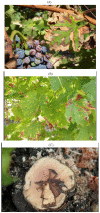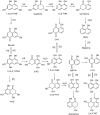Phytotoxins produced by fungi associated with grapevine trunk diseases
- PMID: 22295177
- PMCID: PMC3268457
- DOI: 10.3390/toxins3121569
Phytotoxins produced by fungi associated with grapevine trunk diseases
Abstract
Up to 60 species of fungi in the Botryosphaeriaceae family, genera Cadophora, Cryptovalsa, Cylindrocarpon, Diatrype, Diatrypella, Eutypa, Eutypella, Fomitiporella, Fomitiporia, Inocutis, Phaeoacremonium and Phaeomoniella have been isolated from decline-affected grapevines all around the World. The main grapevine trunk diseases of mature vines are Eutypa dieback, the esca complex and cankers caused by the Botryospheriaceae, while in young vines the main diseases are Petri and black foot diseases. To understand the mechanism of these decline-associated diseases and the symptoms associated with them, the toxins produced by the pathogens involved in these diseases were isolated and characterised chemically and biologically. So far the toxins of only a small number of these decline fungi have been studied. This paper presents an overview of the toxins produced by the most serious of these vine wood pathogens: Eutypa lata, Phaeomoniella chlamydospora, Phaeoacremonium aleophilum and some taxa in the Botryosphaeriaceae family, and examines how these toxins produce decline symptoms. The chemical structure of these metabolites and in some cases their vivotoxin nature are also discussed.
Keywords: black dead arm; Botryosphaeria canker; Eutypa dieback; Fomitiporia; Phaeoacremonium; Phaeomoniella; esca; eutypiosis; grapevine trunk diseases; phytotoxins.
Figures

















References
-
- Carter M.V. Phytopathological Paper No. 32. CAB International; Wallingford, Oxon, UK: 1991. The Status of Eutypa Lata as a Pathogen.
-
- Mugnai L., Graniti A., Surico G. Esca (black measles) and brown wood-streaking: Two old and elusive diseases of grapevines. Plant Dis. 1999;83:404–418. - PubMed
-
- Fischer M. Biodiversity and geographic distribution of basidiomycetes causing esca-associated white rot in grapevine: A worldwide perspective. Phytopathol. Mediterr. 2006;45:S30–S42.
-
- Halleen F., Fourie P.H., Crous P.W. A review of black foot disease of grapevine. Phytopathol. Mediterr. 2006;45:S55–S67.
-
- Surico G., Mugnai L., Marchi G. Older and more recent observations on esca: A critical overview. Phytopathol. Mediterr. 2006;45:S68–S86.
Publication types
MeSH terms
Substances
LinkOut - more resources
Full Text Sources
Other Literature Sources

